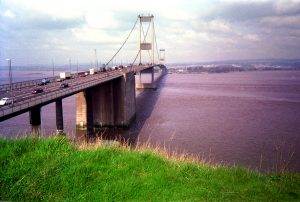 The village of Aust on the River Severn Estuary is the venue around which Effigy of the Cloven Hoof is set. I have always been fascinated with this village because Aust is the surname of my father’s family which emigrated from England in 1893.
The village of Aust on the River Severn Estuary is the venue around which Effigy of the Cloven Hoof is set. I have always been fascinated with this village because Aust is the surname of my father’s family which emigrated from England in 1893.
The village has been inhabited since at least Roman times because of its location at the narrowest point on the Severn Estuary which separates England from southern Wales. The one-mile distance made it a desirable place for ferry crossings which began in Roman times and continued until the 20th century when the first of two motorway bridges was built near Aust in 1966 for the M4 traffic from London and southern England going into Wales. That bridge is pictured above. Its construction ended the ferry service of almost two millennia, but I have worked the medieval ferry into my story which is set in the year 1400.
A second motorway bridge was later built just south of Aust, and these two bridges seemed to lead to the lack of purpose for the village. Amenities such as the post office which existed on my first visit in 1986 was shut down early in the 1990’s. The medieval parish church had been declared redundant and closed to all visitors in those days. Only one single pub was open in Aust, The Boar’s Head, and it continued to be prospering, perhaps in part because Aust was located midway between Bristol and Cardiff with easy access to and from the M4 motorway. Businessmen from these cities liked to meet there for lunch.
In recent years, I have felt better times were growing in Aust, perhaps as a suburb of Bristol. There is more activity in the village, homes are being improved and built. Aust looks more prosperous, and the parish church, which had never been given a name, has been reopened as a chapelry of the Church of England. For the first time in its history, the church has a name, the Chapelry of St. John, and has services as part of the rota of the multi-point parish of the nearby villages.
I have used Aust’s location on the Severn as an important setting in the opening of my first book. The Severn Estuary flowing past the village has enormous tides, averaging 50 feet between low and high tides. This is almost as large as the 56 feet difference between low and high tides found in the Bay of Fundy in North America. The movement of water rushing up or down the River Severn as the tides change is considerable and required great skill of the ferrymen who manned the Aust Ferry.
 The shape of the Bristol Channel (or Severn Channel as it is sometimes called by the locals) and the Severn Estuary, as shown in the map on the left means that an incoming tide is constantly funneled down to a narrower width as it moves up the Severn. In fact, it can become a tidal wave called the Severn Bore. A fictional description of one of them is a real natural disaster which I use in my story. My husband and I watched one of the largest of the 20th century in 1993, and I can attest that it is impressive.
The shape of the Bristol Channel (or Severn Channel as it is sometimes called by the locals) and the Severn Estuary, as shown in the map on the left means that an incoming tide is constantly funneled down to a narrower width as it moves up the Severn. In fact, it can become a tidal wave called the Severn Bore. A fictional description of one of them is a real natural disaster which I use in my story. My husband and I watched one of the largest of the 20th century in 1993, and I can attest that it is impressive.
One of these tidal bores happens during a major storm in the opening chapters of Effigy of the Cloven Hoof, causing the natural disaster which kills many innocent people and adds to the chaos which introduces the story.